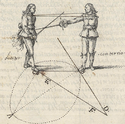|
|
You are not currently logged in. Are you accessing the unsecure (http) portal? Click here to switch to the secure portal. |
Pablo de Paredes
| Domingo Luis Godinho | |
|---|---|
| Born | date of birth unknown |
| Died | after 1599 |
| Period | 16th century |
| Occupation | Fencing master |
| Nationality | Portuguese |
| Movement | Esgrima común |
| Influences | |
| Genres | Fencing manual |
| Language | Spanish |
Domingo Luis Godinho was a late 16th century Portugese fencing master. Little is known of this master's life, but in 1599 he wrote a treatise on fencing entitled Do Arte de Esgrima ("On the Art of Fencing"). Although written after Jerónimo Sánchez de Carranza developed the Verdadera Destreza, Godinho's terminology and techniques appear to align with surviving fragments of the esgrima común ("common fencing") of earlier Iberian masters such as Jaime Pons, Pedro de la Torre, and Francisco Román.[1] His work also shows some similarities to the work of the French master Henry de Sainct Didier, though that is likely due to both sharing similar influences.[citation needed] Do Arte de Esgrima contains information on sword alone, sword and shield, sword and buckler, sword and dagger, sword and cloak, double swords, and the montante.[1]
Contents
Treatise
Transcription | |
|---|---|
Rules or Canons of the Two-Handed Sword:
|
Regles ou Canons de l’espée à deux mains.
|
For further information, including transcription and translation notes, see the discussion page.
| Work | Author(s) | Source | License |
|---|---|---|---|
| Images | |||
| Translation | |||
| Transcription |
Additional Resources
References
- ↑ 1.0 1.1 Tim Rivera. Early Iberian Fencing. Spanish Swordsmanship Society, 2012. Retrieved 28 September 2013.
- ↑ Vuelta could be a turn of the sword or the body, depending on context.
- ↑ Cenido is probably analogous to the Portuguese cingido. I translated cingindo as circling in the Memorial, but there is likely more to it than that. Cegando is probably "sawing", meaning slicing not chopping (Capoferro uses this term as well), but it could also mean "blinding". Figueiredo doesn't give us enough info to clearly define it. I like firm-footed too, but in several traditions that term is used to describe a lunge, meaning that one foot is firm instead of both moving. That's my only reason for using "standing still".
|
|||||||||||||||||||||||||||

